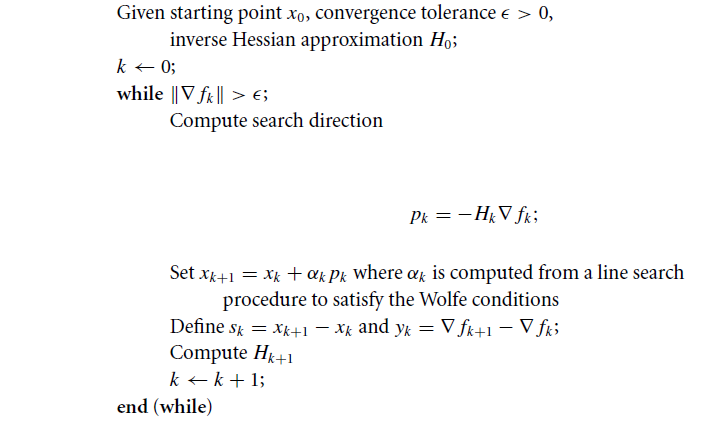BFGS method or one of the most effective optimization methods. Python implementation example

Метод BFGS, итерационный метод численной оптимизации, назван в честь его исследователей: Broyden, Fletcher, Goldfarb, Shanno. Относится к классу так называемых квазиньютоновских методов. В отличие от ньютоновских методов в квазиньютоновских не вычисляется напрямую гессиан функции, т.е. нет необходимости находить частные производные второго порядка. Вместо этого гессиан вычисляется приближенно, исходя из сделанных до этого шагов.
Существует несколько модификаций метода:
L-BFGS (ограниченное использование памяти) — используется в случае большого количества неизвестных.
L-BFGS-B — модификация с ограниченным использованием памяти в многомерном кубе.
The method is effective and stable, therefore it is often used in optimization functions. For example, in SciPy, a popular library for the python language, the optimize function uses BFGS, L-BFGS-B by default.
Algorithm
Let some function be given
Where in the general case
Step # 1
Initialize the starting point
We set the accuracy of the search.
We determine the initial approximation
How to choose the initial approximation
Unfortunately, there is no general formula that works well in all cases. As the initial approximation, we can take the Hessian of the function calculated at the initial point
Step No. 2
We find the point in the direction of which we will search, it is determined as follows:
Step №3
Calculate
Coefficient
Constants
In fact, we find this
Step №4
Determine the vector:
Step # 5
Update the Hessian function, according to the following formula:
Where
Comment
View expression
Let two vectors be defined
Step 6
The algorithm continues to be executed until the inequality is true:
Algorithm schematically

Example
Find the extremum of the following function:
As a starting point we take
Required accuracy
Find the gradient of the function
Iteration No. 0 :
Find the gradient at the point
Check for the end of the search:
Inequality does not hold, so we continue the iteration process.
We find the point in the direction which we will search:
Where
We are looking for this
Analytically, the problem can be reduced to finding the extremum of a function of one variable:
Then
Simplifying the expression, we find the derivative:
Find the next point
Calculate the value of the gradient in t.
Find the Hessian approximation:
Iteration 1:
Check for the end of the search:
The inequality does not hold, so we continue the iteration process:
We find
Then:
Calculate the value of the gradient at the point
Iteration 2 :
Check for the end of the search:
Inequality is fulfilled hence the search ends. Analytically find the extremum of the function, it is achieved at the point
More about the method
Each iteration can be done with a cost.
Very little theoretically is known about the convergence of the algorithm for the case of a non-convex smooth function, although it is generally accepted that the method works well in practice.
The BFGS formula has self-correcting properties. If the matrix
Python implementation example
The algorithm is implemented using the numpy and scipy libraries. A linear search was implemented by using the line_search () function from the scipy.optimize module. In the example, a limit on the number of iterations is imposed.
'''
Pure Python/Numpy implementation of the BFGS algorithm.
Reference: https://en.wikipedia.org/wiki/Broyden%E2%80%93Fletcher%E2%80%93Goldfarb%E2%80%93Shanno_algorithm
'''
#!/usr/bin/python
# -*- coding: utf-8 -*-
import numpy as np
import numpy.linalg as ln
import scipy as sp
import scipy.optimize
# Objective function
def f(x):
return x[0]**2 - x[0]*x[1] + x[1]**2 + 9*x[0] - 6*x[1] + 20
# Derivative
def f1(x):
return np.array([2 * x[0] - x[1] + 9, -x[0] + 2*x[1] - 6])
def bfgs_method(f, fprime, x0, maxiter=None, epsi=10e-3):
"""
Minimize a function func using the BFGS algorithm.
Parameters
----------
func : f(x)
Function to minimise.
x0 : ndarray
Initial guess.
fprime : fprime(x)
The gradient of `func`.
"""
if maxiter is None:
maxiter = len(x0) * 200
# initial values
k = 0
gfk = fprime(x0)
N = len(x0)
# Set the Identity matrix I.
I = np.eye(N, dtype=int)
Hk = I
xk = x0
while ln.norm(gfk) > epsi and k < maxiter:
# pk - direction of search
pk = -np.dot(Hk, gfk)
# Line search constants for the Wolfe conditions.
# Repeating the line search
# line_search returns not only alpha
# but only this value is interesting for us
line_search = sp.optimize.line_search(f, f1, xk, pk)
alpha_k = line_search[0]
xkp1 = xk + alpha_k * pk
sk = xkp1 - xk
xk = xkp1
gfkp1 = fprime(xkp1)
yk = gfkp1 - gfk
gfk = gfkp1
k += 1
ro = 1.0 / (np.dot(yk, sk))
A1 = I - ro * sk[:, np.newaxis] * yk[np.newaxis, :]
A2 = I - ro * yk[:, np.newaxis] * sk[np.newaxis, :]
Hk = np.dot(A1, np.dot(Hk, A2)) + (ro * sk[:, np.newaxis] *
sk[np.newaxis, :])
return (xk, k)
result, k = bfgs_method(f, f1, np.array([1, 1]))
print('Result of BFGS method:')
print('Final Result (best point): %s' % (result))
print('Iteration Count: %s' % (k))
Thank you for your interest in my article. I hope she was useful to you and you learned a lot.
FUNNYDMAN was with you. Bye everyone!
